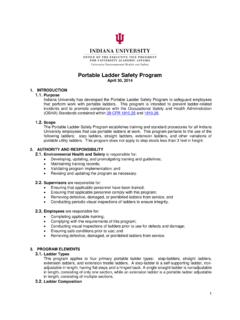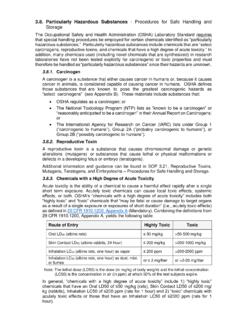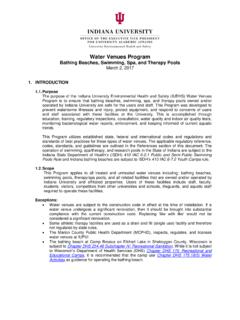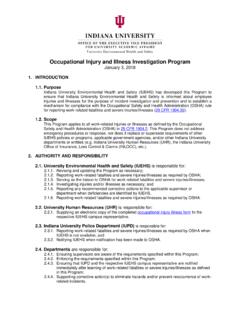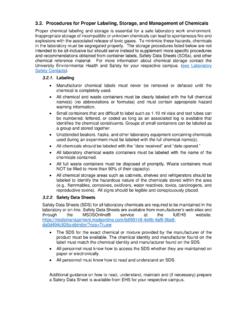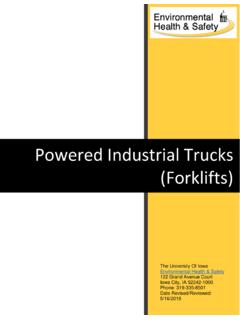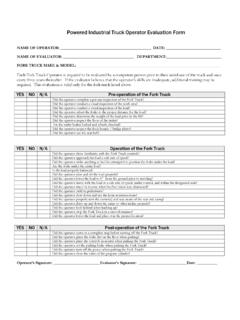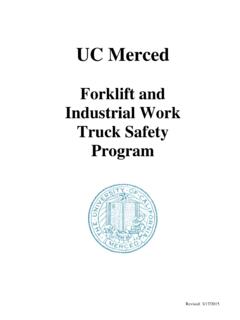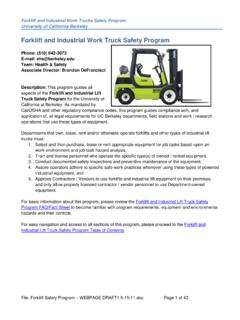Transcription of Powered Industrial Truck Program - protect.iu.edu
1 1 Powered Industrial Truck Program May 1, 2014 1. INTRODUCTION Purpose Indiana University Environmental Health and Safety (IUEHS) developed this Program to ensure a safe work environment and to protect the health and safety of Indiana University employees who operate or maintain Powered Industrial trucks (PITs). The Occupational Safety and Health Administration (OSHA), per 29 CFR , states in part, only trained and authorized operators shall be permitted to operate a PIT. Scope The Powered Industrial Truck Program applies to all Indiana University departments that operate and/or maintain specialized Industrial trucks Powered by electric motors or internal combustion engines. This includes all self-propelled, material delivery vehicles or self- propelled, fork lift vehicles that the operator walks with, stands on, or sits on. Excluded from the scope of this Program include: compressed air or nonflammable compressed gas-operated Industrial trucks, farm vehicles, and any vehicles primarily used for earth moving or over-the-road hauling.
2 2. AUTHORITY AND RESPONSIBILITY Environmental Health and Safety is responsible for: 1. Reviewing the PIT Program to assure compliance; 2. Coordinating and providing training to affected employees; and 3. Maintaining training records of all operators. Supervisors are responsible for: 1. Ensuring employees attend training and operate PITs in a safe manner; 2. Ensuring all equipment is in proper working condition; 3. Assuring operators perform appropriate pre-operation safety inspections and complete log books prior to operating equipment; 4. Inspecting emergency eyewash stations and documenting on a weekly basis; 5. Scheduling maintenance by outside contractors; 6. Inspecting daily log books on a monthly basis; and 7. Maintaining required documentation. Employees are responsible for: 1. Complying with the PIT Program ; 2. Completing the required training prior to operating a PIT; 3.
3 Conducting the pre-use inspection prior to operating the PIT; 4. Ensuring safe operation of the PIT; and 5. Reporting unsafe conditions and any incident to supervisor and taking PIT out of service if needed. 2 3. Program ELEMENTS General Requirements for Powered Industrial Trucks Only trained and authorized operators shall be permitted to operate a PIT; Modifications and additions that affect capacity and the safe operation of the PIT shall not be performed by any employees without the manufacturer s prior written approval. Capacity, operation, and maintenance instruction plates, tags, or decals shall be modified accordingly; If the PIT is equipped with front-end attachments other than factory installed attachments, the PIT shall be marked to identify the attachments and show the approximate weight of the Truck and attachment combination at maximum elevation with load laterally centered; Nameplates and markings shall be in place and maintained in a legible condition; Department will conduct an assessment of the areas in which Powered Industrial trucks are used within their departments to determine if specialty designed equipment may be required.
4 Use OSHA Standard 29 CFR (c) for reference to determine areas which may be designated hazardous locations. If designated locations exist which require specially designed and tested Industrial trucks, notify Environmental Health and Safety for your respective campus for assistance in determining which type of Industrial Truck to use; All PITs approved for fire safety purposes must bear a label or other identifying mark indicating approval by the testing laboratory; and Any PIT not in safe operating condition shall be removed from service. All repairs shall return to the manufacturer s specifications. No PIT shall be put back into service until all repairs have been made. Pre-Operation Safety Inspection Prior to operating a PIT, the employee shall perform a pre-operation safety inspection as follows using the appropriate Operator Inspection Checklists in Appendix B-1 and B-2: This inspection shall be made at least daily when the PIT is used; When PITs are used on a round-the-clock basis, they shall be examined before each shift; The inspection shall identify any conditions that could affect the safe operation of the PIT; If any unsafe condition(s) exist, the PIT shall be removed from service and tagged Out of Service until the proper repairs or concerns are addressed; Upon an operator discovering any operation or safety concerns, immediately notify the supervisor so they can notify the person responsible for the repairs; and Only outside contractors qualified to repair PITs shall perform all repairs and adjustments.
5 Fuel Handling and Storage The handling and storage of liquid fuels such as gasoline shall be in accordance with the National Fire Protection Association (NFPA) Flammable and Combustible Liquids Code (NFPA 30). The handling and storage of liquefied petroleum gas fuel shall be in accordance with the Storage and Handling of Liquefied Petroleum Gases Code (NFPA 58). The following procedures shall be followed: Battery charging installations shall be located in areas designated for that purpose; When refueling or recharging the batteries of a PIT, the operator shall ensure that the PIT is shut-off and the parking brake is engaged; Facilities shall be provided for flushing and neutralizing spilled electrolyte and for protecting charging apparatus from damage by trucks; Refueling and recharging shall be completed in areas that are designated and well ventilated; 3 Personal protective equipment (approved face shield, goggles, gloves) shall be worn during all inspections, refueling and battery filling/charging operations; propane tank change-outs, and any other potentially hazardous operation; For battery charging areas; an emergency eyewash/shower station shall be present in the area.
6 Smoking shall be prohibited in refueling and recharging areas. Fuel vapors and gases, which can escape from the battery and fuel vents, are extremely flammable; Check the level on the battery monthly; and When charging batteries, acid shall be poured into water; water shall not be poured into acid. Workplace Hazards Many hazards exist in the workplaces which are easily detectable if a survey of the area is conducted. These hazards include, but are not limited to, the following: Overhead obstructions such as fire protection sprinkler piping, ventilation ducts, lighting fixtures, power lines. If the load being moved is carried too high or the PIT mast is raised too high, damage can occur to the overhead obstruction and possibly cause injury to the operator or people in the immediate area; Co-workers or pedestrians traveling to and from certain areas within the facility; Poor housekeeping such as wet floors and debris left on the floor; Poor condition of the floor surface such as uneven concrete, potholes and cracks; Poor visibility around corners.
7 The operator s view from a PIT can be blocked or obstructed by the load. If there is not a clear view, drive in reverse or have a co-worker, spotter , direct you; Operating a PIT in a confined area with poor ventilation can allow the PIT exhaust gases and contaminants to accumulate. This creates a hazard not only for the PIT operator, but also for others within the area or building. Environmental Health and Safety for your respective campus shall be contacted to evaluate the air quality if concerns should arise; For individuals who wear eyeglasses, entering a warm atmosphere from a cold atmosphere (driving into a building from the outside) will cause eyeglasses to steam up reducing vision; and Driving too fast for the conditions of the area. When operating a PIT, always remain alert and cautious. Note the existing and potential hazards and conditions that do or could exist in the work environment.
8 Whenever a hazard is discovered which requires action such as housekeeping, poor floor condition or poor ventilation, immediately notify the supervisor to ensure the proper procedures are followed to address the hazards. Operating Procedures When operating a PIT, always travel with the forks approximately four inches from the ground so they clear any uneven surfaces or as low as possible. Always survey the area ahead and to the sides when traveling. Always travel in reverse or use a spotter when the load being carried obstructs the view. Some factors that could cause the PIT to tip over: Overloads; Unstable loads; Load not centered on forks; Traveling with the load raised; Traveling at excessive speeds; Sudden stops and starts; Making sharp turns; and Traveling across a ramp or incline. Safety Practices The following safety practices shall be adhered to at all times: 4 Wear seatbelts whenever the PIT is equipped with them; Keep all body parts inside the driver s compartment; Drive at appropriate speeds; Do not carry passengers on the PIT; No person shall be permitted to stand or pass under elevated portions of any PIT, whether loaded or empty; When traveling behind other PITs or vehicles, always maintain at least three PIT lengths from the vehicle or PIT ahead, and maintain control of the PIT at all times; Slowly approach ramps and inclines straight, not at an angle; Never turn the PIT while on a ramp or incline; When parking a PIT and prior to dismounting or leaving the unit, shut-off the power.
9 The operator shall never leave a running PIT unattended; When the PIT is left unattended, the load shall be fully lowered, controls shall be neutralized, power shut off, brakes set and wheels blocked if PIT is parked on an incline; Never park a PIT in front of any fire protection equipment, emergency exits, or in a manner that would obstruct a person from exiting the area; If at any time during operation a PIT is found to be in need of repair, defective, or in any way unsafe, it shall be immediately removed from service. The supervisor shall be notified so they can contact the person responsible for the repairs; and Refueling and recharging area shall be equipped with an emergency eyewash station. Emergency eyewash stations shall be inspected on a weekly basis. 4. TRAINING & RECORDKEEPING Initial Training Indiana University employees designated to operate a Powered Industrial Truck shall be required to participate in and successfully complete a PIT training Program approved by Indiana University Environmental Health and Safety (IUEHS) to ensure the operator is competent to operate a PIT safely before assuming their responsibilities.
10 The supervisor shall ensure that each PIT operator is competent to operate a Powered Industrial Truck safely. Prior to permitting an employee to operate a PIT (except for training purposes), the supervisor shall ensure that each operator has successfully completed the Indiana University Lift Truck Operator required training and has a valid Operator Certification Card. All operator training and evaluation shall be conducted by persons who have the knowledge, training, and experience to train PIT operators and evaluate their competence. Training consists of a combination of formal instruction and practical training. Formal instruction includes lecture, interactive discussion, video, and written material handouts. Practical training includes demonstrations performed by the trainer, practical exercises performed by the trainee, and evaluation of the operator s performance in the workplace.
